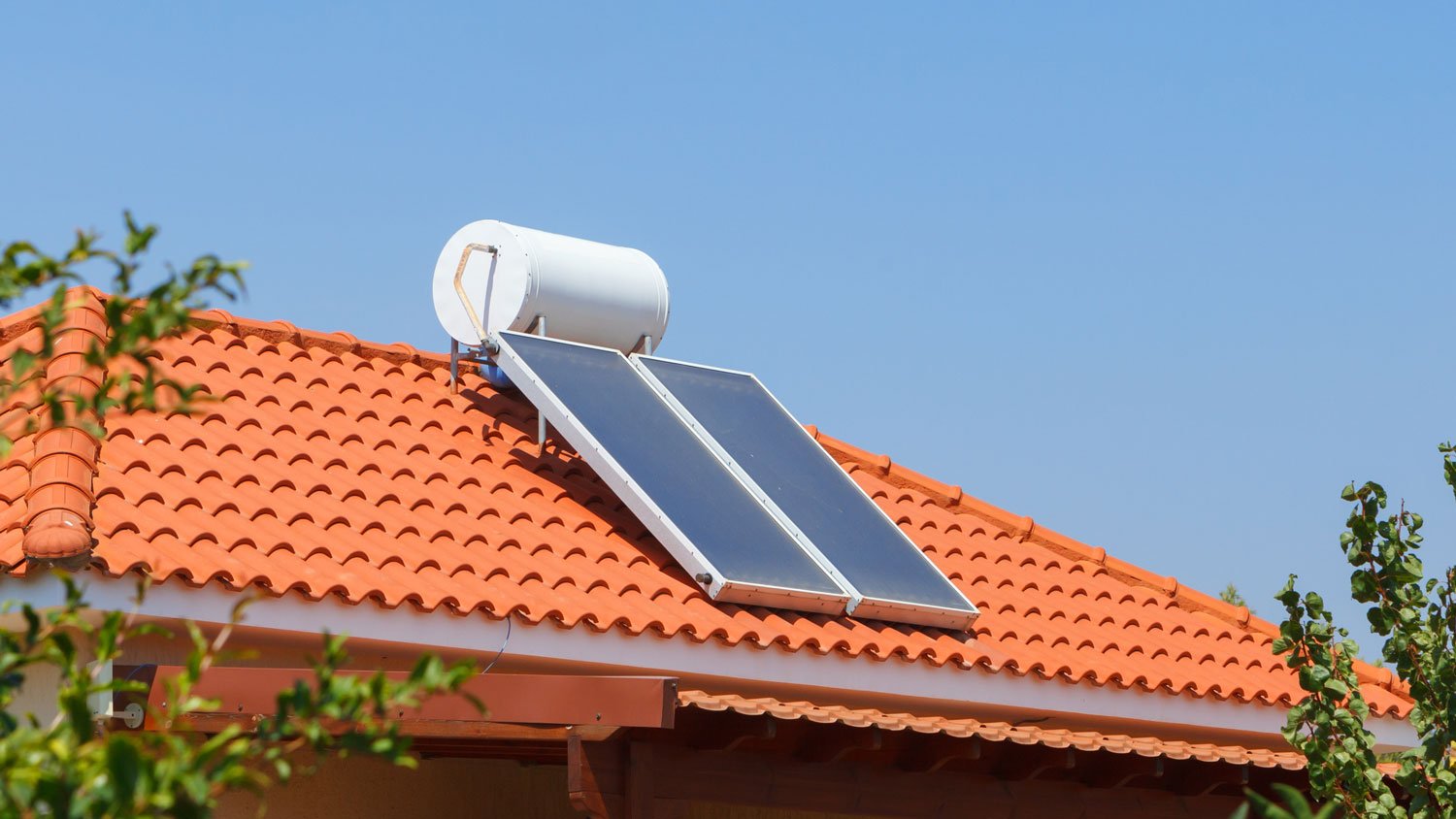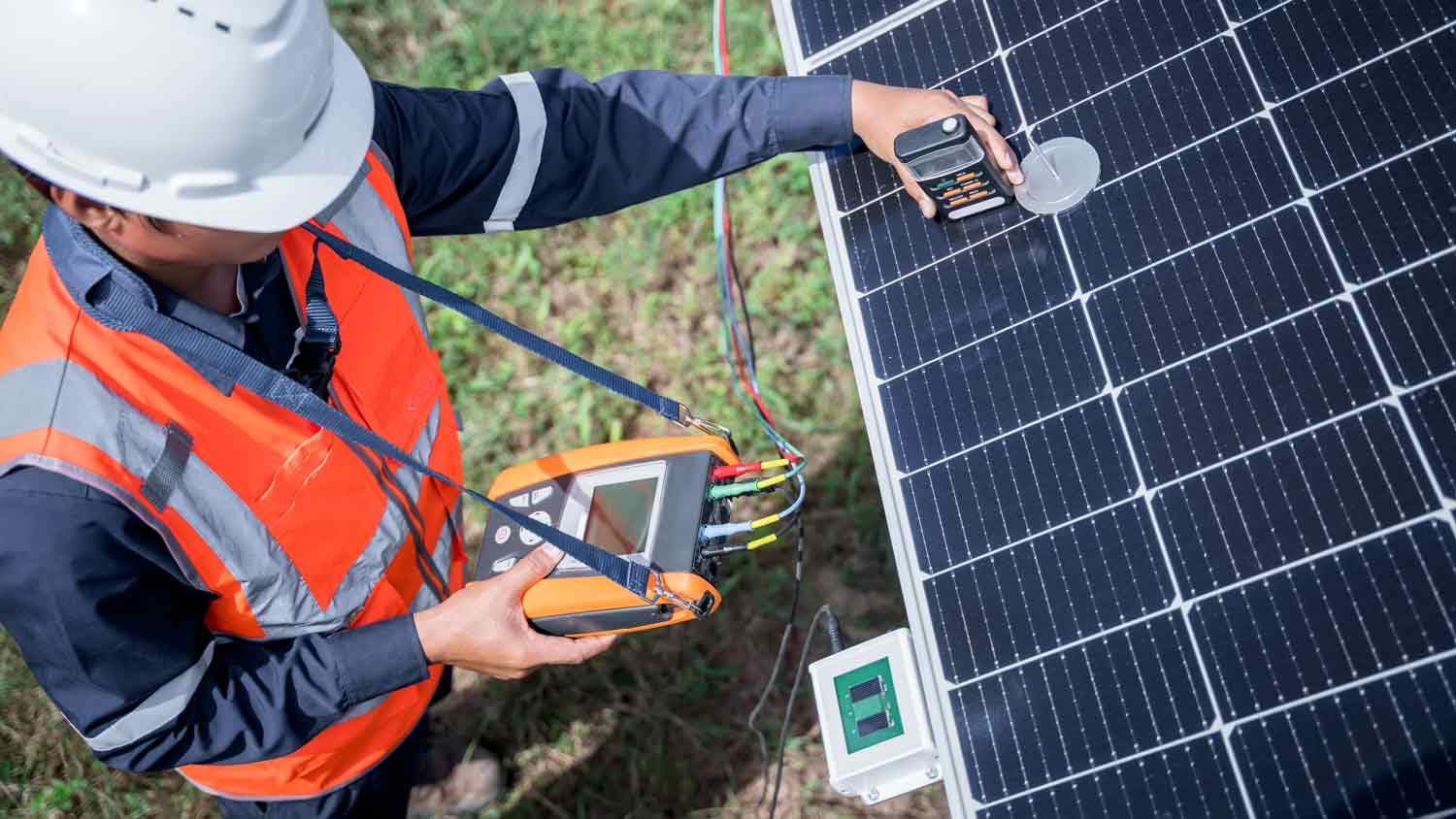
Solar battery costs depend on the size of your system, labor, and capacity. Learn how much you could pay for batteries for home solar systems.
Harness the sun’s rays to heat your abode


Solar thermal collectors use radiant heat to warm the air and water in your home.
Most homes use non-concentrated solar thermal collectors, whereas industrial settings use concentrated ones that are more powerful.
Flat plates and solar bowls collect the sun’s rays, while hot water systems and panels may be able to warm your home by trapping ambient air.
From warming hot water to heating your home, heat makes up the brunt of most electricity bills. By capturing natural heat from the sun, homeowners can use solar thermal collectors to convert solar radiation into energy that powers their home.
The components used to achieve this goal, however, can vary, as can the parts, size, and shape of the device. Let’s break down six different solar thermal systems—flat plate, thermodynamic, solar bowl, hot water systems, evacuated tube, and parabolic—so you can decide what’s right for your home.
One difference to explore first in solar thermal collectors is concentrating versus non-concentrating solar thermal collectors.
Non-concentrating solar thermal collectors use one (or a small handful) of angles to absorb solar radiation. They’re generally mounted in a fixed position, meaning the number of hours per day they can collect sunlight is limited.
Concentrating thermal collectors use mirrors and sensors to optimize the amount of solar radiation collected throughout the day, and are generally speaking, much more powerful.
In most cases, homes use non-concentrated solar energy solutions. Industrial and utility settings most frequently call for concentrated products.
Characterized by a flat collection plate with an insulated cover fixed over it, flat plate solar collectors are some of the oldest designs and have been around for over 75 years.
Basically, the flat plate solar panel is mounted on a roof and warmed by the sun during hours where it’s exposed, then transfers that energy into heat that’s used for the water and air in a home. Solar panels like this are typically mounted at a southern angle on your home to allow for maximum light exposure.
| Pros | Cons |
|---|---|
| Common and widely used | Fixed in place |
| Mounted on the roof | |
| Lower cost than other systems |
Best for: A simple solar thermal collector set-up
.jpeg?impolicy=leadImage)
A newer product, thermodynamic panels offer the unique benefit of collecting heat from two sources: the sun and the air. This means that on warm, cloudy days, thermodynamic panels still can operate and gather natural energy for your home. It might also negate the need to remove trees to install solar panels to increase light exposure.
Because of this, thermodynamic panels are often double categorized as both one of the different types of solar panels or heat pumps you can install in your home, and may be marketed as such.
| Pros | Cons |
|---|---|
| Collects energy from air and heat | Not as common in the U.S. as other types |
| Works even if sunlight is low | May not be as efficient in colder climates |
| Doesn’t have to be south facing |
Best for: Homes in warmer climates
One of the most affordable solar thermal options is the solar bowl, which, mounted in a fixed position on your roof, can help keep installation costs low.
The parabolic mirror shape of the solar bowl helps channel the sun’s rays into one concentrated area of the dish. Pipes attached to the unit carry these high concentrations of heat through a fluid solution that’s then used to heat your home.
| Pros | Cons |
|---|---|
| Affordable option | Fixed mirror can’t track the sun |
| Can channel the sun’s rays |
Best for: Homes in lower-sunlight areas
There are two types of solar water heating systems: active and passive. Active systems use a thermal collector, like a flat plate collector, to heat water and then circulate it through the home. Passive systems include a transparent water tank (usually holding 40 to 80 gallons), and the sun heats the water directly before it is transferred to the plumbing system.
The one drawback, or thing to at least consider, is that hot water systems almost always recommend a backup mechanism for cloudy, cool days. High demand households may need a stronger system.
| Pros | Cons |
|---|---|
| Works with any type of solar collector | Likely requires a backup mechanism |
| Two types to choose from: active or passive | Passive systems aren’t as efficient as active |
Best for: Homeowners who want an efficient hot water heater
Commonly referred to as ‘ETCs’, evacuated tube collectors are lined with glass tubes containing copper, which boasts an impressive combination of high natural heat conductivity and affordability, especially when compared to other metals such as silver.
ETCs are considered more efficient than flat plate collectors, as they can hold onto heat from previously warmer days better than flat plates, which comes in handy during a cold spell or series of high-energy use days. And because of the circular tubes, they are exposed to the sun from different angles as the sun moves through the sky throughout the day.
| Pros | Cons |
|---|---|
| More efficient than other systems | More expensive than a flat plate collector |
| Hold heat from previously warm days |
Best for: Homeowners who want to maximize energy collection
Parabolic solar collectors, or parabolic solar troughs, are a type of concentrating solar power collector. The curved, parabolic shaped panel is able to reflect sunlight from the surface of the collector to a collection focal point called the receiving tube or absorber. This type of system tracks the sun’s movement from east to west and can collect more energy than a flat plate system. It’s more often used in commercial applications than in residential applications and takes up more space than a standard rooftop system.
| Pros | Cons |
|---|---|
| Collects more solar energy than a flat plate | Larger space requirements |
| Creates very high temperatures for heating | Used more for commercial applications |
| Movable parts need more maintenance |
Best for: Commercial applications or homeowners with a large amount of land to dedicate to the system
It’s easy to get solar collectors and solar panels confused because they both convert the sun’s radiation into energy. But the end result is different. Solar collectors turn the sun’s radiation into heating energy that can be used to heat your home or your water. Solar panels convert sunlight into electricity that you can use to power your home. In some cases, solar panels will generate enough energy that you can store it in solar batteries or sell it to the utility company.
When considering solar panels, you’ll need to assess your roof's age, size, pitch, and shape. The trees shading your home will also impact whether rooftop solar panels are the best option. A solar panel installation pro can assess your roof and recommend the next steps.
In most cases, it’s best to hire a pro to install solar for your home. A local solar installation professional will be able to assess your home’s energy needs and make recommendations for the best system. The company will also be qualified to install the system and make sure it’s properly connected to your home and the grid.
From average costs to expert advice, get all the answers you need to get your job done.

Solar battery costs depend on the size of your system, labor, and capacity. Learn how much you could pay for batteries for home solar systems.

Discover the average solar panel inspection cost, what impacts pricing, and how to save. Get expert tips to keep your solar system efficient and safe.

There are a few factors to consider when it comes to solar panel repair costs. This guide breaks down the prices of solar panel removal, repair, and replacement.

Solar panels are low-maintenance but occasionally require some elbow grease. This guide will help you learn how often solar panel maintenance is required.

Are you planning to go solar? This guide will explain the different types of solar inverters and help you choose the best one for your home.

You’ve seen solar panels on home roofs, but can you put solar panels on mobile homes? The answer is maybe—dig in to find out all the details.